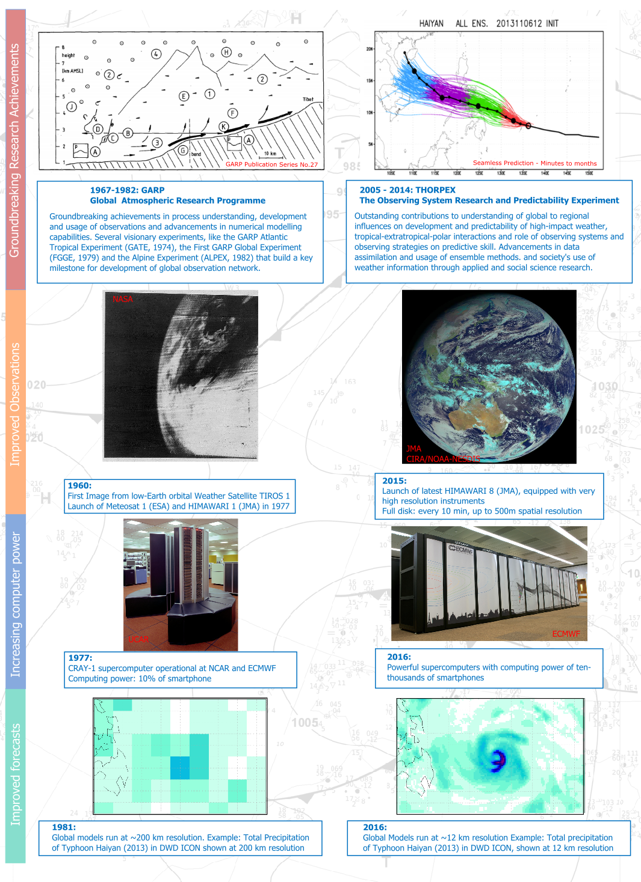WWRP Background
The WMO World Weather Research Programme (WWRP) promotes international and interdisciplinary research for more accurate and reliable forecasts from minutes to seasons, expanding the frontiers of weather science to enhance society’s resilience to high-impact weather and the value of weather information for users. WWRP aims at Seamless Prediction by increasing convergence between weather, climate and environmental approaches. WWRP strengthens academic – operational partnerships and interdisciplinary collaborations, and enhances the role of Early Career Scientists.
All WWRP research activities demonstrate the usefulness of international research and its applications in an operational framework by playing a vital role in to strengthen national research capacity and services worldwide, and thereby contributing to sustainable development aspirations.
The World Weather Research Programme was established in 1998 to address the growing societal impacts of high-impact weather events through advances in prediction research identified and developed by scientific working groups and projects focused in specific high priority areas. As an international programme of WMO, WWRP both helps initiate international and national research projects related to weather prediction and allows them to function more effectively. WWRP activities are overseen by WMO’s Research Board on Weather, Climate, Water and the Environment (formerly by Commission for Atmospheric Sciences). Since its foundation WWRP has initiated, endorsed, and facilitated numerous international research activities whose scientific challenges have required a critical mass of effort. WWRP’s first Research and Development Project, the Mesoscale Alpine Programme (1999) had aimed to improve forecasts for atmospheric and hydrological processes over mountainous regions.
The Sydney 2000 Forecast Demonstration Project (FDP), which supported the Sydney 2000 Olympics ,aimed to demonstrate the capability of modern forecast systems at that time, and to quantify benefits in providing a real-time nowcast service, especially within an urban environment. The Olympic Games provide important examples of regularly-scheduled, internationally significant events during which there is a very high potential for impacts of severe weather to affect many people. Since the Sydney Olympics FDP several Olympic FDPs have followed, each reflecting state-of-art advances in weather science and services at local to regional scales. Moreover, tropical meteorology research activities have played a pivotal role in developing several regionally focused projects since the beginning of WWRP. The quadrennial International Workshop on Tropical Cyclones (IWTC) provides an important platform for coordination and exchange among researchers and forecasters.
In 2003, WMO established an international atmospheric research and development programme, The Observing system Research and Predictability Experiment – THORPEX (Parsons et al. 2016). As a major 10-year programme, THORPEX built upon the highly successful 15-year Global Atmospheric Research Programme (GARP) initiated in 1967. While GARP focused on clarifying critical but poorly understood aspects of atmospheric dynamics, which eventually led to significant improvements in the accuracy of weather forecasts, the primary goal of THORPEX was “Accelerating improvements in the accuracy of 1-day to 2-week high-impact weather forecasts for the benefit of society, the economy and the environment”. THORPEX provided the essential framework for strong international collaborations in research into dynamics, predictability, and data assimilation, in major field experiments, in the exploitation of observation technologies and the development and use of ensemble prediction techniques. THORPEX fostered increased cooperation between the academic research community and National Meteorological and Hydrological Services (NMHS). Major achievements of THORPEX include addressing the potential of targeted observations through field campaigns, improved understanding of dynamical processes, developing and evaluating new data assimilation techniques and increasing the value of large multi-model ensemble prediction systems through the THORPEX Interactive Grand Global Ensemble (TIGGE) database. Progress has also been made in facilitating the development and application of new and improved verification methods to assess and enable improvement of the quality of weather forecasts, and in the provision of nowcasting information and mesoscale predictions.

The first World Weather Open Science Conference (WWOSC-2014) was held in Montreal, Canada to mark the achievements of THORPEX and define the future research agenda for seamless prediction of the earth system (Seamless Prediction from Minutes to Months, WMO-1156, 2015). This major international conference, the first of its kind for the weather research and operations community provided a critical basis for evaluating the current state of weather science and provided a vital stimulus for setting future research directions. This was accomplished by bringing together the broad weather research community with social scientists and end users from a range of perspectives to examine the rapidly changing scientific and socio-economic drivers of weather science. Experts reviewed the frontiers of knowledge, discussed the state-of-the-art and the future evolution of weather science, and emerging environmental services and their corresponding research needs.
During the 16th Session (2013) of the WMO Commission for Atmospheric Sciences, a set of six emerging societal and technical challenges and opportunities were identified for the decade to come. Four of these challenges – High-Impact Weather, Water, Urbanization and Evolving Technologies - clearly fall within the scope of WWRP. Facing these emerging challenges, WWRP now enters an era that will require developing new and stronger collaborations with key partners, WMO programmes and international initiatives. Sharing expertise and partnering to meet common objectives will be essential to address emerging societal challenges, and will benefit all who are involved. Past WWRP advances will be built on and extended through the working groups, expert teams and the three new core WWRP projects: the Sub-seasonal to Seasonal Project (S2S), the Polar Prediction Project (PPP) and the High-Impact Weather Project (HIWeather). Each of the projects will help to promote weather research towards achieving increased societal benefits from advances in weather science.
